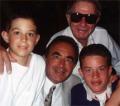| Summary |
Voir Dire is an important process in the court of law during jury selection. During this process, attorneys screen potential jurors to determine their ability to serve on the jury and assess whether they can be impartial and unbiased.
The process of Voir Dire begins with attorneys introducing themselves and briefly explaining the case. They will then ask general questions of the jury panel to gather information. The questions usually involve understanding the jurors' background, their thoughts on the case, and their beliefs and opinions on the law and evidence.
Attorneys will then use this information to make decisions on who to accept or remove from the jury panel. In making these decisions, attorneys are looking for jurors that are impartial, fair and unbiased. There are certain situations where an attorney can get rid of a juror without having to give a reason, known as a peremptory challenge.
Attorneys must also use caution when using peremptory challenges; they must avoid discrimination or they will risk getting the decision overturned. If a peremptory challenge is used to remove a juror based on gender, sexual orientation, religion, race, ethnicity or other notable characteristics, the opposing attorney can file a motion to challenge the decision.
When making decisions during Voir Dire, attorneys should keep in mind what the purpose of the process is - to create an impartial jury. If attorneys have any doubts about a particular potential juror, it may be better to use a peremptory challenge to be safe. With proper knowledge of the law and the court's process, attorneys can effectively select a jury that is unbiased and well suited to the case.
Voir Dire is an important part of the legal process and attorneys must pay close attention to the process to ensure that the jury selection is fair. Attorneys must also be aware of their rights and the other attorney's rights when it comes to the use of peremptory challenges. They should make sure that they are not discriminating against any potential juror and that they are selecting jurors that will be fair and impartial. Doing so will help ensure a successful outcome of the case.
What is Voir Dire?
Voir Dire is a process which allows attorneys to question potential jurors in order to gauge their possible biases or opinions about a case. Attorneys use Voir Dire as a way to assess the impartiality of a jury. Additionally, Voir Dire is used to eliminate jurors who may have preconceived ideas or prejudices about a case.Significant Role of an Attorney
An experienced attorney plays a significant role in Voir Dire. The attorney must have an in-depth understanding of the case and its potential effects on the jurors. The attorney must also anticipate and prepare answers to the questions that potential jurors may ask. It is important that the attorney be able to explain complex legal terminology in an easily understandable manner.Buying Time in Voir Dire
In some cases, an attorney may use the Voir Dire process to buy time. If a case is complicated, the attorney may be able to ask questions that force the jurors to think critically about the case. This can buy the attorney more time to explain the complexities of the case and to build a strong case for their client. Additionally, it can provide the attorney with an opportunity to assess the impartiality of each juror.Using Voir Dire for Testimony
When an attorney is making a case for their client, it is important to use Voir Dire to present testimony from potential jurors. This testimony can be used to bolster the attorney's argument and to establish the bias of each juror. Furthermore, this testimony can be used to demonstrate the merits of the attorney's case.Making the Right Choice in Voir Dire
Attorneys must make the right decision during Voir Dire. It is important to properly evaluate each potential juror in order to ensure that the jury is impartial and that the case will be heard fairly. Attorneys must be able to make the right decision on when to strike a potential juror and when to leave them in the jury pool.<<
Mr. Wright, the author of an upcoming Texas State Bar course entitled "VOIR DIRE: Preparation, Communication, and Presentation Selection, Theory, and Strategy," is familiar with the French pronunciation, but when in West Texas, he chooses a more colloquial pronunciation.
But to the question of voir dire's relative importance, Mr. Wright is unequivocal. "I think it's crucial," he declares.
"I believe voir dire is critical to a case," agrees Charles F. Brega, a partner in the Denver law office of Lindquist & Vennum. "And I can give you several examples of how and why it's important."
One of Mr. Brega's most compelling examples involved a Wyoming case in which several cases were consolidated because they all involved the same issues. The evidence was heard by multiple juries at the same time. Then the juries separated to make their individual decisions regarding the same issues of liability for each respective party. "The defense won some and the plaintiffs won some," Brega notes. To him, that's pretty clear support for the notion that "the person listening to the evidence has a huge impact on the way a case is determined."
But others, when considering the overall trial process, place voir dire in a less critical role.
"We consider voir dire less important," comments David Shafer, Director of Research for Best Evidence, a company that in part specializes in jury consulting. Dr. Shafer places much more emphasis on conducting mock trials and focus groups. And he notes a couple of good reasons he believes those efforts are more important than jury selection.
But at the end of the day, adds Shafer, "you have very little control over what shows up" in your prospective pool of jurors. "And you only have a limited ability to deselect people. So for the most part, you have to play the hand that shows up."
Both Wright and Brega don't disagree with Shafer's notion of juror unpredictability. But from their experience, it is precisely that absence of predictability that makes voir dire so important.
Forming the Ideal Jury
In every civil and criminal trial by jury, lawyers have a variety of ways to create an ideal jury. Most lawyers agree with Dr. Joe Rice, President of Jury Research Institute, a company that specializes in assisting attorneys with jury selection, mock trials, and similar trial techniques. Dr. Rice, who assisted the plaintiffs in the civil case against O.J. Simpson (re: the estate of Nicole Brown Simpson), believes "there are ways to use voir dire effectively to improve the likelihood of getting a jury who will listen." Dr. Rice believes voir dire is really all about juror de-selection. "All you can do is remove people you perceive are bad for your case," explains Rice. "You hope the good jurors remain. You can't protect them," but "you have to be crafty, because you want to expose the bad jurors, but not the good ones."
The most obvious way to de-select jurors is through the use of preemptory challenges. Preemptory challenges involve striking jurors without having to state a reason. The preemptory challenge is a powerful tool, but for obvious reasons it's limited, and no one believes it's the lone, best way to create the ideal jury.
After exhausting preemptory challenges, attorneys can only strike jurors for cause. Cause can involve a variety of reasons and is largely dependent on the nature of the case. For example, in a criminal case that involves the idea of presumption of innocence, jurors who don't believe in the notion could be disqualified.
But here's where the process of jury de-selection becomes more art than science. If you ask a prospective pool of jurors if they believe in the idea of presumption of innocence, everyone would probably respond "yes." But according to Brega, there's a subtler way to get at their true perspective on the question. "Here's the way I ask that question," he explains. "When you came in and saw my client, how many of you said I wonder what he did?" When he asks for a show of hands, he has a good idea of which prospective jurors don't believe in the idea of presumption of innocence.
However, the juror's response to that question is probably not sufficient to strike them for cause. So attorneys like Brega have to figure out how to either get them talking so they strike themselves by their own incriminating comments, or figure out how to begin changing their perspectives to ones more favorable to the case.
In the Nicole Brown Simpson case, Joe Rice and the Jury Research Institute conducted focus groups to determine the strength of opinions of L.A. County residents about O.J. Simpson's guilt or innocence. One of the key points they were trying to figure out was "what kind of evidence and issue would it take to persuade someone that even though O.J. was acquitted" in the criminal trial, "he could still be found liable" in the civil trial. They were looking for jurors who did not express bias toward Simpson or at least whose bias could be addressed.
In voir dire, they could then ask the kinds of questions to determine who among the jurors favored Simpson. After their limited preemptory challenges were exhausted, the trick was to get the remaining prejudicial jurors removed for cause. In order to remove them for cause, the estate's team had to give the jurors "the right questions to commit themselves to an opinion so we could get them removed," explains Rice. "By using open-ended questions, we could get a juror taking about the case." If the juror recalled all the defense themes, but none of the prosecution's evidence, they'd make every effort to strike them for cause.
Brega is quick to point out that, regardless of your ability to get jurors removed or included, the jury-selection phase can also be used to begin making jurors aware of relevant case themes. For example, Brega once represented a doctor who, because of an accident, had his income reduced from $400,000 to $200,000 dollars a year. Brega knew the doctor's large salary was going to be an issue, so during voir dire he asked his prospective jurors, "raise your hand if you think doctors make too much."
Then Brega followed with: "what if he was a plumber and instead of $80,000 per year, an accident reduced his income to $40,000 per year?"
Now Brega has the jury recognizing the size of the salary as an issue and can begin working on the fact that the law would treat the plumber and the doctor the same—so the issue of dollar amount shouldn't even be considered. That way, Brega uses the voir dire to begin addressing potential issues in his case.
In every trial, every lawyer wants to stack his or her jury with those most favorable to the case. Because opposing counsel are always vying for the same thing, no one ever achieves the perfect jury. But a key way to get as close to perfect as possible is through the artful exercise of voir dire.




